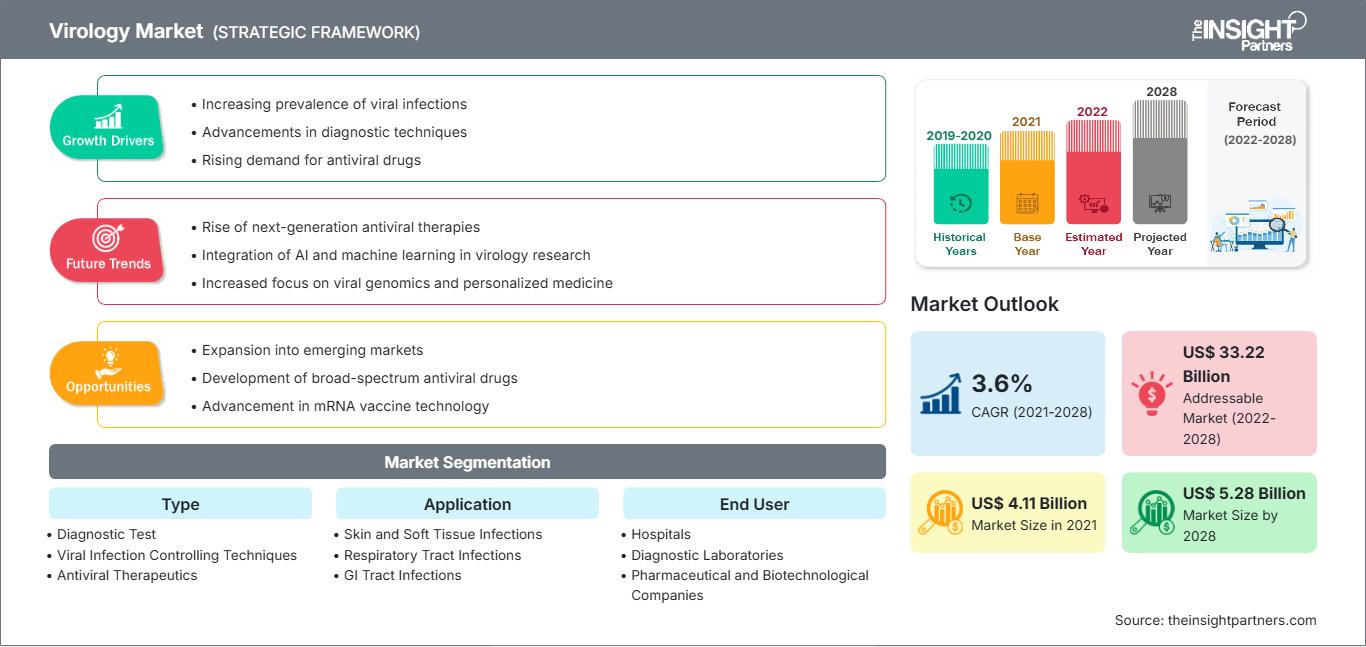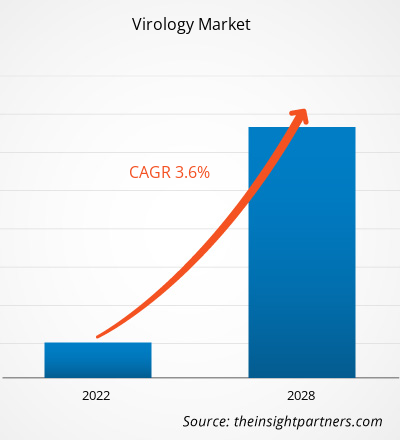Se prevé que el mercado de la virología alcance los 5.276,48 millones de dólares estadounidenses en 2028, frente a los 4.108,27 millones de dólares estadounidenses en 2021; se espera que registre una tasa de crecimiento anual compuesto (TCAC) del 3,6% entre 2021 y 2028.
La virología es una de las áreas más importantes del sistema de salud. Tiene una amplia aplicación en el desarrollo de vacunas, diagnósticos, tratamientos y otros campos. Los participantes del mercado de la virología invierten constantemente en la innovación y el desarrollo de productos para mantenerse competitivos. Exploran diversas vías para la innovación. Por ejemplo, en el caso de la COVID-19, están invirtiendo considerablemente en el desarrollo de vacunas, kits de prueba y otros productos y servicios relacionados. A continuación, se presentan algunos de los avances del mercado de la virología.
- En agosto de 2021, la Administración de Alimentos y Medicamentos de los Estados Unidos (FDA) aprobó la primera vacuna contra la COVID-19, conocida como la vacuna Pfizer-BioNTech . Se comercializará como ComiRNAty (Koe-mir'-na-tee). Esta vacuna está diseñada para prevenir la enfermedad de la COVID-19 en personas de 16 años o más. También está disponible bajo autorización de uso de emergencia ( EUA ).
- En abril de 2021, CerTest Biotec lanzó su prueba de diagnóstico de COVID-19 con marcado CE para el sistema BD MAX.
- En mayo de 2020, Bio-Rad recibió la aprobación de la FDA para la autorización de uso de emergencia de la prueba de anticuerpos totales contra la COVID-19.
- En mayo de 2020, Aalto Bio Reagents lanzó nuevas proteínas Spike S1-S2 recombinantes eucariotas del SARS-CoV-2.
De este modo, la participación activa de los agentes del mercado a través de innovaciones de productos y el apoyo gubernamental en diferentes países impulsa el crecimiento del mercado de la virología.
Obtendrá personalización gratuita de cualquier informe, incluyendo partes de este informe, análisis a nivel de país y paquetes de datos de Excel. Además, podrá aprovechar excelentes ofertas y descuentos para empresas emergentes y universidades.
Mercado de virología: Perspectivas estratégicas

- Obtenga las principales tendencias clave del mercado que se describen en este informe.Esta muestra GRATUITA incluirá análisis de datos, que abarcarán desde tendencias de mercado hasta estimaciones y pronósticos.
Perspectivas del mercado : La creciente adopción de procedimientos estéticos mínimamente invasivos y no invasivos impulsa el crecimiento del mercado de la virología.
Virus como el VIH, el virus de la gripe, el virus del Zika , el virus del Ébola, el SARS-CoV-2 y el poliovirus infectan a grandes poblaciones en todo el mundo. Debido a la continua mutación y evolución de estos virus, la resistencia a los fármacos se convierte en un importante desafío para el control de las infecciones virales en humanos y animales. Un virus se transmite a través de diversos medios según su tipo. Por ejemplo, algunos virus causan enfermedades respiratorias, como la gripe, el resfriado común y la infección por el virus sincitial respiratorio , y se transmiten mediante gotitas generadas al toser o estornudar; mientras que algunas enfermedades gastrointestinales se transmiten por contacto directo con las heces de personas infectadas o a través de alimentos o agua contaminados. Según las estadísticas mundiales de ONUSIDA sobre el VIH/SIDA, más de 37,7 millones de personas en todo el mundo estaban infectadas por el VIH en 2020.
El Comité Internacional de Taxonomía de Virus ( ICTV ) declaró el nuevo coronavirus causante de la COVID-19 como Síndrome Respiratorio Agudo Severo Coronavirus 2 (SARS-CoV-2) en febrero de 2020. El virus ha mutado varias veces desde su brote, lo que ha agravado la pandemia de COVID-19. Por ejemplo, según los datos del rastreador de COVID-19 de los Centros para el Control y la Prevención de Enfermedades (CDC), en agosto de 2021, la tasa de incidencia acumulada a siete días por cada 100.000 habitantes era de 299,4, y se habían notificado más de 164.952 nuevos casos en Estados Unidos. Además, según el Centro Europeo para la Prevención y el Control de Enfermedades, en agosto de 2021 el número total de casos de COVID-19 en el Espacio Económico Europeo ( EEE ) ascendía a aproximadamente 36 307 572. Por lo tanto, esta creciente prevalencia de infecciones virales está impulsando el crecimiento del mercado de la virología.
Perspectivas regionales del mercado de virología
Los analistas de The Insight Partners han explicado detalladamente las tendencias y los factores regionales que influyen en el mercado de la virología durante el período de previsión. Esta sección también analiza los segmentos del mercado de la virología y su distribución geográfica en Norteamérica, Europa, Asia Pacífico, Oriente Medio y África, y Sudamérica y Centroamérica.
Alcance del informe de mercado de virología
| Atributo del informe | Detalles |
|---|---|
| Tamaño del mercado en 2021 | 4.110 millones de dólares estadounidenses |
| Tamaño del mercado para 2028 | 5.280 millones de dólares estadounidenses |
| Tasa de crecimiento anual compuesto global (2021 - 2028) | 3,6% |
| Datos históricos | 2019-2020 |
| período de previsión | 2022-2028 |
| Segmentos cubiertos | Por tipo
|
| Regiones y países cubiertos | América del norte
|
| Líderes del mercado y perfiles de empresas clave |
|
Densidad de los participantes en el mercado de la virología: comprensión de su impacto en la dinámica empresarial
El mercado de la virología está creciendo rápidamente, impulsado por la creciente demanda de los usuarios finales debido a factores como la evolución de las preferencias de los consumidores, los avances tecnológicos y una mayor conciencia de los beneficios del producto. A medida que aumenta la demanda, las empresas amplían su oferta, innovan para satisfacer las necesidades de los consumidores y aprovechan las tendencias emergentes, lo que impulsa aún más el crecimiento del mercado.

- Obtenga una visión general de los principales actores del mercado de la virología.
Perspectivas basadas en tipos
Según su tipo, el mercado de la virología se segmenta en pruebas diagnósticas, técnicas para el control de infecciones virales, terapias antivirales e interferones. Se prevé que en 2021, el segmento de pruebas diagnósticas ostente la mayor cuota de mercado, mientras que se estima que el segmento de técnicas para el control de infecciones virales registre la mayor tasa de crecimiento anual compuesto (TCAC) entre 2021 y 2028.
Información basada en aplicaciones
Según su aplicación, el mercado se segmenta en infecciones de piel y tejidos blandos, infecciones del tracto respiratorio, infecciones del tracto gastrointestinal, enfermedades de transmisión sexual, infecciones del tracto urinario y otras. Se estima que en 2021, el segmento de infecciones del tracto respiratorio ostentó la mayor cuota de mercado y se prevé que registre la mayor tasa de crecimiento anual compuesto (TCAC) durante el período 2021-2028.
Las empresas que operan en el mercado de la virología hacen hincapié en la adopción de estrategias de innovación de productos para satisfacer las cambiantes demandas de los clientes en todo el mundo, lo que también les permite mantener su prestigio de marca a nivel global.
Mercado de virología: segmentación
Por tipo
- Prueba diagnóstica
- Pruebas de virus de ADN
- Pruebas de virus de ARN
- Otros
- Técnicas de control de infecciones virales
- Profilaxis activa
- Profilaxis pasiva
- Terapéutica antiviral
- Agentes viricidas
- Agentes antivirales
- Inmunomoduladores
- interferones
Por solicitud
- Infecciones de piel y tejidos blandos
- Infecciones del tracto respiratorio
- Infecciones del tracto gastrointestinal
- Enfermedades de transmisión sexual
- Infecciones del tracto urinario
- Otros
Por usuario final
- hospitales
- Laboratorios de diagnóstico
- Empresas farmacéuticas y biotecnológicas
- Institutos de Investigación y Académicos
Por geografía
- América del norte
- A NOSOTROS
- Canadá
- México
- Europa
- Francia
- Alemania
- Italia
- Reino Unido
- España
- El resto de Europa
- Asia Pacífico
- Porcelana
- India
- Corea del Sur
- Japón
- Australia
- Resto de Asia Pacífico
- Oriente Medio y África
- Sudáfrica
- Arabia Saudita
- Emiratos Árabes Unidos
- Resto de Oriente Medio y África
- América del Sur y Central
- Brasil
- Argentina
- El resto es ESTAFA
Perfiles de empresas
- Abbott
- Servicios de Johnson & Johnson, Inc.
- F. Hoffmann-LA Roche Ltd.
- Thermo Fisher Scientific, Inc.
- Qiagen
- Illumina, Inc.
- Siemens AG
- GlaxoSmithKline Plc
- Gilead Sciences, Inc.
- AbbVie, Inc. © nombres de derechos de autor en sus respectivos sitios web.
- Análisis histórico (2 años), año base, pronóstico (7 años) con CAGR
- Análisis PEST y FODA
- Tamaño del mercado, valor/volumen: global, regional y nacional
- Industria y panorama competitivo
- Conjunto de datos de Excel
Informes recientes
Testimonios
Razón para comprar
- Toma de decisiones informada
- Comprensión de la dinámica del mercado
- Análisis competitivo
- Información sobre clientes
- Pronósticos del mercado
- Mitigación de riesgos
- Planificación estratégica
- Justificación de la inversión
- Identificación de mercados emergentes
- Mejora de las estrategias de marketing
- Impulso de la eficiencia operativa
- Alineación con las tendencias regulatorias






















 Obtenga una muestra gratuita para - Mercado de virología
Obtenga una muestra gratuita para - Mercado de virología